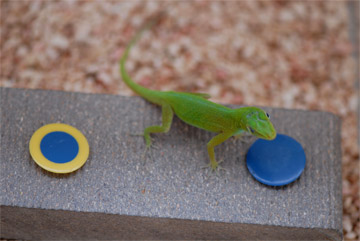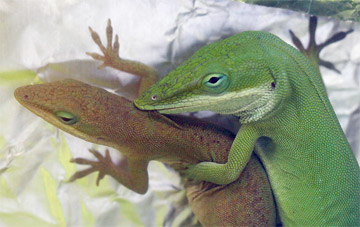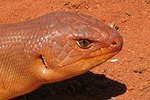Reptiles have long been thought to be dim-witted, but a new study in Biology Letters finds that the Puerto Rican anole, a type of lizard, can match birds in smarts. Using cognitive tests that have been previously used on birds, researchers with Duke University found that the lizards were capable of solving a problem they’ve never encountered before, remembering the solution in future trials, and even changing techniques when presented with new challenges. In fact, the tiny anoles solved the test with fewer tries than birds. Given reptiles’ reputation of being slow-on-the uptake the head author, Manuel Leal, said the findings are ‘completely unexpected’.
 Puerto Rican anoles, Anolis evermanni, were tested on a food-finding apparatus normally used on birds. The lizards showed they could solve a novel problem, remember solutions and “unlearn” incorrect approaches. Credit: Manuel Leal, Duke University |
For the test the Puerto Rican anoles (Anolis evermanni) were provided with two wells, one held a tasty worm but was covered by a cap, while the other was empty. To reach the reward–the worm–the anoles had to bump or bite the cap out of the way. On average the lizards solved the problem with three fewer tries than birds.
“They’d put their snout under the little plastic chip and then quickly bump it,” Leal said in a press release. “They don’t do this in the wild.”
The lizards were only given one chance per day, while birds were given several every day. If the lizard didn’t succeed they had to wait 24 hours for the next opportunity to feed.
Next researchers put two caps–one bright and one dull–over the wells, and the lizards quickly learned to associate the bright cap with the worm, ignoring the dull one. After this, the researchers tried to trick the lizards: they switched the worm, hiding it under the dull cap. This proved more difficult. But after a few trials, two of the four lizards began to flip the dull cap instead of the bright one.
“We named these two Plato and Socrates,” Leal says.
 A related species of anole, but not used in the research. |
While the study found unexpected cognitive abilities in the lizards, an expert on bird intelligence, Louis Lefebvre with McGill University, says that the study doesn’t necessarily mean lizards are smarter than birds since birds still have larger body-to-brain ratios than reptiles. Instead it may mean that anoles are among the most intelligent of the reptiles.
“We know birds and mammals have bigger brains and that within bird species and within mammal species, the bigger the brain is, the higher the chance of that larger-brained species making it when moving to a new environment,” Lefebvre said in a press release. “It may be the same with lizards.”
Anoles have been shown to be especially successful at surviving in new habitats. There are over 400 species of anoles, making them the largest genus in the reptile class.
For his part, Leal plans to test other lizards and compare body-to-brain size this year.
For decades researchers have discovered that the world’s animals are often far more clever than society has given them credit for. Along with the great apes, crows and octopus have been shown to use tools. Bees can count. Hens experience empathy for their chicks. Paper wasps can other recognize wasp-faces. The more we learn about animal intelligence, the less distinct we are.
Related articles
World’s ‘most social’ lizard builds multigenerational homes

(05/31/2011) Researchers from Macquarie University in Australia have discovered that the threatened great desert burrowing skink lizard forms stable families that construct and maintain elaborate underground homes, reports ABC News. This is the first lizard in the world known to practice such familial behavior. Native to central Australia, researchers are conducting studies on the great desert skink (Liopholis kintorei) at Uluru Kata-Tjuta National Park, where rangers monitor the threatened species. Over 5,000 species of lizard have been documented globally, but only the Uluru skinks live together in immediate and social families that invest in the construction of long-lasting homes.
With 24 eyes, box jellyfish are constantly looking up
(04/28/2011) Lacking brains does not mean box jellyfish are incapable of complex visual behavior, according to a new study in Current Biology. Researchers have known for over a century that box jellyfish support an astounding two-dozen eyes. Now, they are beginning to find out how these eyes are used: four of a box jellyfish’s 24 eyes are always peering up out of the water finds the new study. These four eyes, no matter how the body is oriented, allow the jellyfish to navigate their shallow, obstacle-filled habitats, such as mangroves—and keep them from straying too far from home.
Critically endangered capuchins make tools to gather termites
(03/10/2011) Less than 200 blond capuchins (Cebus falvius) survive in the highly-fragmented habitat of Brazil’s Atlantic Forest. But this tiny group of monkeys, only rediscovered in 2006, is surprising scientists with its adept tool-using abilities. Displaying similar behavior to that which made the chimpanzees of Gombe famous worldwide, the blond capuchins modify sticks to gather termites from trees; however, according to the study published in Biology Letters the blond capuchins use two techniques never witnessed before: twisting the stick when inside the termite nest and tapping the nest before inserting the stick.
Elephants cooperate as well as chimps
(03/07/2011) A new study proves that elephants understand how sometimes two is better than one. Working with Asian elephants (Elephas maximus) at the Thai Elephant Conservation Center, researchers reconstructed a classic cooperation test that was originally developed for chimpanzees. Subjects must pull on a rope to receive a reward, such as food, however—and here’s the crux—the treat is only released if two subjects cooperate by pulling on two different ropes simultaneously. The paper published in Proceedings of the National Academy of Sciences found that elephants were as capable of cooperation as chimpanzees.
Scientists discover that bats practice oral sex
(10/28/2009) The short-nosed fruit bat Cynopterus sphinx is the first bat species to have been observed engaging in oral sex.